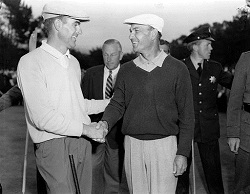Ben Hogan at the Century County Club, The Beginning of His Career
 The end of Ben Hogan’s brilliant golf career in many ways came to its sad conclusion when an unknown municipal golf pro named Jack Fleck upset him at the 1955 U.S. Open played at the Olympic Club in San Francisco.
The end of Ben Hogan’s brilliant golf career in many ways came to its sad conclusion when an unknown municipal golf pro named Jack Fleck upset him at the 1955 U.S. Open played at the Olympic Club in San Francisco.
Capturing that moment again for us are two great books that have just been published: The Longest Shot by Neil Sagebiel (Thomas Dunne Books) and The Upset by Al Barkow (Chicago Review Press). These books read like novels (even though we know the outcome) and they take us back once more to that suspenseful summer Sunday in mid-June of ’55.
These books also bring the golf world into focus with the return next week to Olympic Club of the 2012 U.S. Open.
For a certain generation of golfers who can never read enough about Ben Hogan, both accounts of that tournament are great reads. Finally we have worthy bookends to a special moment in American golf history.
As we all remember ‘moments’ when time stood still, I can still recall that Sunday afternoon in 1955 when I heard Hogan had been tied in the final round of the Open by someone named Jack Fleck. Home from college, and working at my summer job as Caddie Master at Midlothian Country Club, south of Chicago, I simply dismissed anyone named Fleck from Davenport, Iowa winning the Open. I mean, I had been to Davenport, and no one from there and named ‘Fleck’ could defeat the wondrous Ben Hogan.
How little did I know.
I have made a lifetime part-time hobby of mine researching Hogan’s history, and even based one of my novels, The Caddie Who Knew Ben Hogan on the Hawk.
And since I live in Westchester, New York, a few years ago I went searching for his early career, when he was the home pro at Century Country Club in nearby Purchase, N.Y.
What I learned was that in 1938 Century went searching for a professional golfer to work as the teaching assistant to Dan Mackie, then the club’s home pro. Someone mentioned Ben Hogan as a possibility.
It was decided to check out Hogan through Frederick Hellman, brother of former member Marco “Mickey” Hellman, of the Wells Fargo Bank, when the new tour reached California.
According to records kept at the club, in February of 1938, Ted Low wrote Hellman thanking him for his help, “I received your telegram saying that you had seen Ben Hogan and that he made a nice appearance.”
Hogan was hired and that summer of ’38 he went back east to take over as the teaching pro at Century. His salary was $500 a year, plus food and lodging.
It was also that year, in September 1938, that Hogan, paired with Vic Ghezzi, won the Hershey Four-Ball, his first pro victory.
Hogan always admitted he was not a gifted teacher of the game. In his classic book, Five Lessons: The Modern Fundamentals of Golf written with Herbert Warren Wind and published first in 1957, a book that still sells nearly 100,000 paperback copies a year, Hogan wrote, “I didn’t and don’t have the ideal temperament for teaching,” In this book he also notes, “Quite early in my career when I was serving as the professional at the Century Country Club in Purchase, N.Y., I did a great deal of teaching.”
When he wasn’t teaching, he was practicing. “He lived on the practice range,” says Nelson Long, the club’s current and long-time head pro. “We had a member here who passed away a few years ago but remembered Hogan from his time at the club. He said that whenever Hogan gave a playing lesson with a member, however, he had the habit of look away when the member swung, so as not to be influenced by a bad swing.”
Hogan did draw on his lessons at Century in writing Five Lessons.“There was a young businessman at my club, Fred Ehrman, who had this ability to learn, and we did a very satisfying job together. He was a 90-shooter in April. Five months later he was playing the 70s and won the club championship.”
It was while giving lessons at Century that Hogan began to develop his understanding of the dynamics of the golf swing, which, he said, he fully understood by 1946, his first great year on the PGA tour.
“Beginning in 1946,” Hogan writes, “I was able to win some of the big championships, and being able to win was the proof I needed that what I felt was correct was indeed correct.” Hogan would win 13 times in ’46, including his first major, the PGA.
In 1940 Dan Mackie was pensioned off at Century and Hogan became the head pro. He was 28 years old. Hogan would stay as home pro only that summer. He moved next to Pennsylvania and replaced Henry Picard at Hershey Country Club. Also in 1940, Hogan would win his first PGA tournament on his own, the North and South Open.
From then on, Ben Hogan would play onto greatness. And in all those years to come everyone asked: would anyone ever surpass Hogan’s ability?
Hogan answered that question himself. In 1940 he said, “It is my conviction that is the years ahead there will be many changes in style and form, just as there have been in the past. We never come anywhere near reaching perfection-that is always something left to improve.”
Well, Ben was right. Today we have metal woods, belly-putters, spherically tiled dimple designed golf balls, and, of course, Tiger.
No comments yet.
Add your comment